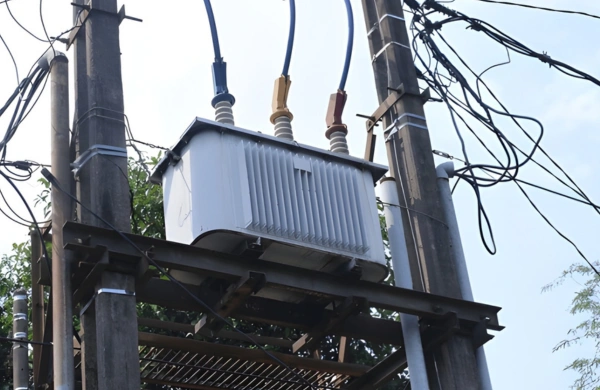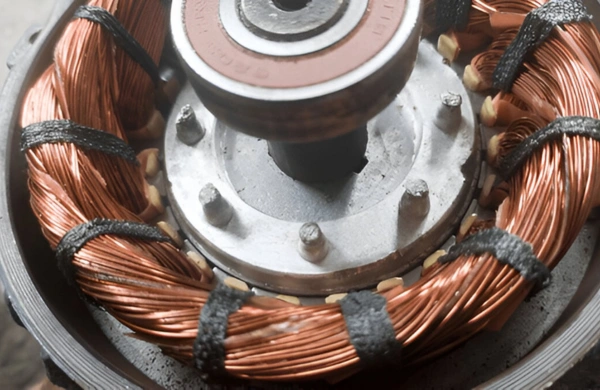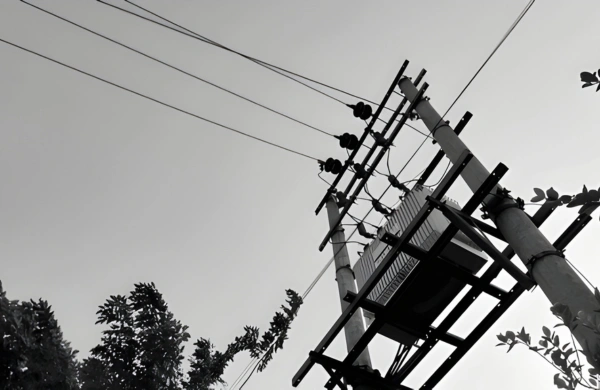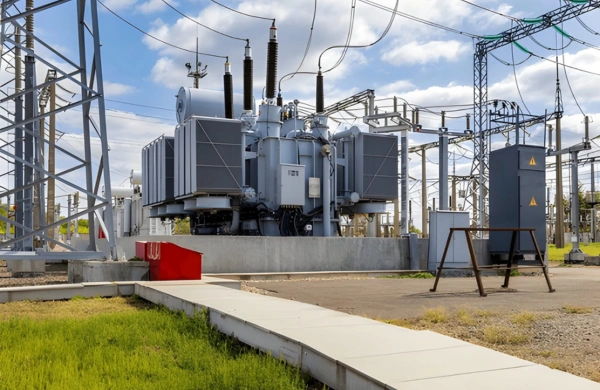Introduction
Electrical systems across industries depend on controlled voltage levels to power machinery, automation panels, and sensitive instruments. Any voltage fluctuation or inconsistency can lead to overheating, component failure, or costly downtime. The voltage step down transformer provides a proven, efficient solution — ensuring stable, isolated, and reliable power for all downstream equipment.
These transformers are designed to convert high incoming voltage to a lower, safe, and usable level while maintaining insulation integrity and minimizing losses.
Zetwerk, a global manufacturing leader, produces precision-engineered voltage step down transformers optimized for industrial safety and performance. Built to IEC, IEEE, and ANSI standards, Zetwerk’s transformers deliver consistent voltage regulation, long life, and proven reliability for North American power networks and facilities.
Know About Reliable Voltage Step Down Transformers
for Equipment Protection
1. The Importance of Voltage Step Down Transformers in Equipment Safety
High-voltage power supplied from grids or substations must be reduced to operating levels suitable for industrial and commercial equipment. Step down transformers perform this critical function while ensuring complete electrical isolation between supply and load circuits.
Core safety and protection benefits include:
- Equipment protection: Prevents voltage surges and overcurrent damage.
- Operator safety: Electrical isolation reduces shock hazards.
- System stability: Ensures smooth power delivery under variable loads.
- Longevity: Reduces thermal stress and premature equipment wear.
In sectors such as manufacturing, utilities, oil and gas, and data centers, these transformers are indispensable for maintaining uptime, safety, and efficiency.
2. Core Design and Construction
Zetwerk designs its step down transformers for precision, durability, and performance under demanding industrial conditions.
Core:
Constructed from high-grade CRGO steel laminations or amorphous metal to minimize magnetic losses and operational noise. Optimized stacking ensures uniform flux distribution and energy efficiency.
Windings:
Copper or aluminum conductors are wound with precision-controlled tension to maintain accurate turn ratios. Multi-layered insulation and interleaved winding techniques reduce leakage reactance and improve short-circuit strength.
Insulation:
Class F (155°C) or H (180°C) insulation systems provide thermal endurance under full-load conditions. Each winding undergoes vacuum impregnation with high-grade epoxy varnish to prevent moisture ingress.
Enclosure:
Transformers are housed in IP-rated, corrosion-resistant enclosures suitable for indoor or outdoor service. Ventilation or sealed options are available based on the duty cycle and environmental conditions.
Cooling:
- Air Natural (AN) for compact or indoor setups.
- Air Forced (AF) or Oil Natural Air Natural (ONAN) for higher capacities.
Every unit is thermally modeled to ensure consistent cooling and low operating temperatures.
3. Electrical Performance and Efficiency
Zetwerk’s step down transformers are engineered for low losses, high efficiency, and consistent voltage regulation.
Typical specifications:
- Primary Voltage: Up to 33 kV
- Secondary Voltage: 120 V to 690 V
- Frequency: 50 Hz or 60 Hz
- Efficiency: ≥98.5% for industrial-grade units
- Voltage Regulation: ±1.5% at full load
- Insulation Level: BIL up to 95 kV
- Thermal Class: F or H based on duty requirements
Each unit undergoes precision testing to ensure minimal no-load and load losses, guaranteeing energy-efficient performance and cost savings over its service life.
4. Role in Industrial Equipment Protection
Step down transformers protect electrical equipment from faults, transients, and overloads by providing:
- Voltage isolation: Prevents high-voltage transients from reaching control circuits.
- Current limitation: Reduces the impact of inrush and short-circuit currents.
- Ground fault prevention: Minimizes earth leakage through proper shielding and grounding.
- Consistent voltage delivery: Ensures stable supply for PLCs, sensors, and automation systems.
Applications span across:
- CNC machinery and robotics
- Process control equipment
- Motor drives and HVAC systems
- Lighting and instrumentation networks
- Renewable and distributed energy systems
Every Zetwerk transformer integrates seamlessly into electrical protection schemes, maintaining consistent power delivery and compliance with UL and IEC standards.
5. Testing, Standards, and Quality Assurance
Each Zetwerk transformer is type-tested and routine-tested as per IEC 60076, IEEE C57.12, and ANSI standards to ensure reliability and compliance.
Tests include:
- Ratio and polarity verification
- Insulation resistance and dielectric strength
- No-load and load loss measurement
- Impulse voltage withstand test
- Temperature rise and thermal endurance
- Partial discharge and sound level testing
Zetwerk’s in-house high-voltage laboratories feature automated testing systems with real-time data acquisition for precision and repeatability. Test results are digitally logged and supplied with every shipment, ensuring transparency and traceability.
6. Oil-Immersed vs Dry-Type Designs
Zetwerk manufactures both oil-immersed and dry-type (VPI or cast resin) transformers based on operating environment and safety requirements.
Oil-Immersed Step Down Transformers:
- Suitable for outdoor and high-power applications.
- Provide superior cooling and overload capacity.
- Filled with degassed mineral or ester-based insulating oil.
- Periodic oil filtration ensures long service life.
- Ideal for indoor, enclosed, or environmentally sensitive areas.
- Non-flammable and moisture-resistant.
- Minimal maintenance with lower noise and footprint.
Zetwerk engineers help customers select the right transformer type for specific site conditions, duty cycles, and safety requirements.
7. Customization and Engineering Support
Zetwerk’s design flexibility allows customers to configure transformers based on project specifications.
Customization options include:
- Voltage ratio: Tailored to exact grid or load requirements.
- Tap changer: Off-load or on-load options for voltage fine-tuning.
- Mounting configurations: Floor, wall, or pole-mounted designs.
- Cooling systems: AN, AF, ONAN, ONAF, or OFAF.
- Enclosure rating: IP23 to IP65 with anti-corrosion coatings.
- Winding material: Copper or aluminum options based on efficiency targets.
Each transformer is engineered to optimize footprint, efficiency, and thermal behavior, ensuring long-term field performance.
8. Safety, Reliability, and Compliance
Zetwerk places safety at the core of its transformer design philosophy. Every unit incorporates multiple protective features that exceed international safety norms.
Safety features include:
- Thermal protection relays and embedded PT100 sensors.
- Electrostatic shielding between primary and secondary windings.
- Pressure relief valves and Buchholz relays (for oil-immersed units).
- Grounding and short-circuit protection.
- Flame-retardant and self-extinguishing materials.
Compliance with UL, CSA, and NFPA guidelines ensures suitability for North American installations.
9. Manufacturing Excellence at Zetwerk
Zetwerk’s vertically integrated manufacturing process combines advanced automation, digital monitoring, and strict process control.
Manufacturing process highlights:
- CNC core cutting and stacking: Maintains consistent lamination geometry.
- Automated winding machines: Guarantee precise conductor layering.
- Vacuum drying and impregnation: Removes moisture for enhanced dielectric life.
- Oil filtration and degassing (for liquid-filled models): Ensures purity and stability.
- Factory Acceptance Testing (FAT): Validates all performance parameters under simulated load conditions.
Zetwerk’s manufacturing facilities are ISO 9001, ISO 14001, and ISO 45001 certified, ensuring consistent quality, environmental responsibility, and workplace safety.
10. Zetwerk’s Capabilities for North American Markets
Zetwerk’s transformer division supports industrial and utility clients across North America with end-to-end manufacturing, design, and delivery capabilities.
Key strengths:
- Production capacity up to 400 MVA, 400 kV class.
- Design compliance with IEEE, IEC, ANSI, and CSA standards.
- Export-ready documentation and packaging per North American codes.
- Fast prototyping and serial production for OEMs and EPCs.
- Custom engineering support for automation, renewable, and grid applications.
With dedicated project teams and proven quality consistency, Zetwerk ensures North American customers receive dependable transformers with optimized lifecycle performance.
Conclusion
Reliable power conversion and equipment protection begin with high-quality step down transformers. Whether powering process machinery, control systems, or data infrastructure, these transformers ensure safe voltage levels, isolation, and operational stability.
Zetwerk manufactures voltage step down transformers engineered for precision, endurance, and compliance with global standards. Built with advanced materials and automated processes, every unit delivers reliable performance, thermal stability, and long operational life.




By combining design expertise, testing infrastructure, and manufacturing excellence, Zetwerk supports North American industries in achieving efficient, safe, and sustainable electrical power systems.
FAQs
a. It reduces high input voltage to a safe, usable level while providing isolation and equipment protection.
a. They’re widely used in manufacturing, oil & gas, utilities, data centers, and infrastructure projects.
a. Zetwerk offers air-cooled (AN/AF) and oil-cooled (ONAN/ONAF) options.
a. Yes. Voltage ratios, tap settings, and enclosure ratings can be tailored for project needs.
a. Yes. All units are tested to meet IEC, IEEE, ANSI, and CSA standards.








